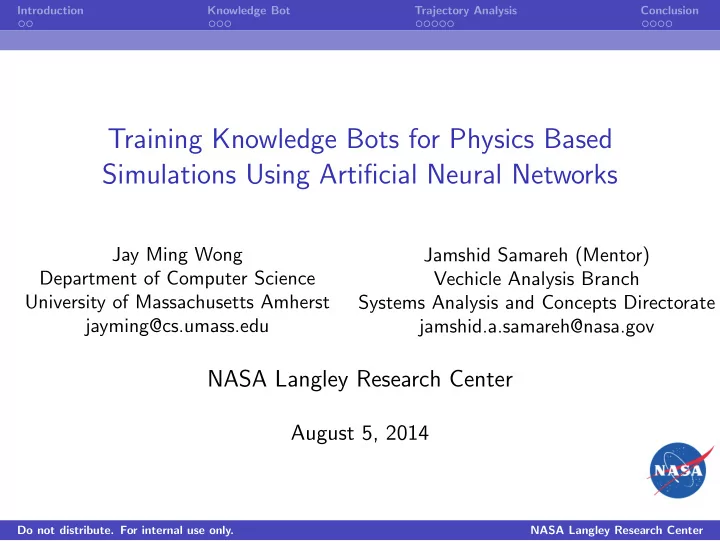

Introduction Knowledge Bot Trajectory Analysis Conclusion Training Knowledge Bots for Physics Based Simulations Using Artificial Neural Networks Jay Ming Wong Jamshid Samareh (Mentor) Department of Computer Science Vechicle Analysis Branch University of Massachusetts Amherst Systems Analysis and Concepts Directorate jayming@cs.umass.edu jamshid.a.samareh@nasa.gov NASA Langley Research Center August 5, 2014 Do not distribute. For internal use only. NASA Langley Research Center
Introduction Knowledge Bot Trajectory Analysis Conclusion Overview Introduction Purpose and Motivation Knowledge Bot Training the Knowledge Bot for Physics Based Simulations Trajectory Analysis Trajectory Analysis with POST2, Program to Optimize Simulated Trajectories Conclusion Summary and Final Thoughts Do not distribute. For internal use only. NASA Langley Research Center
Introduction Knowledge Bot Trajectory Analysis Conclusion Purpose and Motivation Purpose of the Knowledge Bot Role of the knowledge bot in system analysis and design process Do not distribute. For internal use only. NASA Langley Research Center
Introduction Knowledge Bot Trajectory Analysis Conclusion Purpose and Motivation Purpose of the Knowledge Bot ◮ In system analysis the following physics base simulations are essential in the design and analysis process, 1. Computational Fluid Dynamics (CFD) 2. Trajectory Analysis (POST2) 3. Finite Element Analysis (NASTRAN) Do not distribute. For internal use only. NASA Langley Research Center
Introduction Knowledge Bot Trajectory Analysis Conclusion Training the Knowledge Bot for Physics Based Simulations Approach User-Bot relationship Do not distribute. For internal use only. NASA Langley Research Center Hyperbolic Wave Equation
Introduction Knowledge Bot Trajectory Analysis Conclusion Training the Knowledge Bot for Physics Based Simulations Classification Results Hyperbolic Wave Equation Parabolic 1D Heat Conduction Elliptic Laplaces’ Equation Pressure Vessel Design Slosh Propellant Dynamics Venus Direct Entry Trajectory Do not distribute. For internal use only. NASA Langley Research Center
Introduction Knowledge Bot Trajectory Analysis Conclusion Training the Knowledge Bot for Physics Based Simulations Classification Results Hyperbolic Wave Equation Parabolic 1D Heat Conduction Elliptic Laplaces’ Equation Pressure Vessel Design Slosh Propellant Dynamics Venus Direct Entry Trajectory Do not distribute. For internal use only. NASA Langley Research Center
Introduction Knowledge Bot Trajectory Analysis Conclusion Trajectory Analysis with POST2, Program to Optimize Simulated Trajectories Direct Entry Problem Illustration of direct entry concept 1 1 http://cosmology.com/Mars128.html Do not distribute. For internal use only. NASA Langley Research Center
Introduction Knowledge Bot Trajectory Analysis Conclusion Trajectory Analysis with POST2, Program to Optimize Simulated Trajectories Direct Entry Problem ◮ Purpose was to observe atmospheric-assisted direct entry of a 45-degree sphere-cone vechicle using d (diameter), m (mass), v e (entry velocity), γ e (entry flight path angle) on planet Venus ◮ Find region where successful entries and failed entries will occur at, some instances may be captured some may not ◮ Train neural network to classify when success or failure will occur based on input parameters ◮ Probabilistically sampled 0 . 5 m ≤ d ≤ 4 . 0 m ; 500 kg ≤ m ≤ 5000 kg ; 10 km / s ≤ v e ≤ 13 km / s ; and − 30 o ≤ γ e ≤ 0 o ◮ Use SVM to discover clear bounday between success and failure ◮ Describe the boundary in a clear expression with least squares Do not distribute. For internal use only. NASA Langley Research Center
Introduction Knowledge Bot Trajectory Analysis Conclusion Trajectory Analysis with POST2, Program to Optimize Simulated Trajectories Classification Results of Atmospheric-assisted Direct Entry ◮ Classification Plot demonstrates instances and their predictions ◮ γ e , J ( d , m , v e ) boundary using SVM and least squares Do not distribute. For internal use only. NASA Langley Research Center
Introduction Knowledge Bot Trajectory Analysis Conclusion Trajectory Analysis with POST2, Program to Optimize Simulated Trajectories Classification Results of Atmospheric-assisted Direct Entry ◮ Classification Plot demonstrates instances and their predictions ◮ γ e , J ( d , m , v e ) boundary using SVM and least squares Do not distribute. For internal use only. NASA Langley Research Center
Introduction Knowledge Bot Trajectory Analysis Conclusion Trajectory Analysis with POST2, Program to Optimize Simulated Trajectories What is J ( d , m , v e )? ◮ J ( · ) is an expression relating d , m , v e to γ e along the classified border between success and failure in direct entry ◮ J ( d , m , v e ) = γ e lies along the border J ( d , m , v e ) = 0 . 0219 m 0 . 0096 v 0 . 6646 d − 0 . 0017 (1) e 1. if γ e < J ( d , m , v e ), direct entry failure 2. if γ e > J ( d , m , v e ), direct entry sucess ◮ Artificial neural network classification shown to be over 99 . 6% accurate Do not distribute. For internal use only. NASA Langley Research Center
Introduction Knowledge Bot Trajectory Analysis Conclusion Summary and Final Thoughts Recall... Classification Results Hyperbolic Wave Equation Parabolic 1D Heat Conduction Elliptic Laplaces’ Equation Pressure Vessel Design Slosh Propellant Dynamics Venus Direct Entry Trajectory Do not distribute. For internal use only. NASA Langley Research Center
Introduction Knowledge Bot Trajectory Analysis Conclusion Summary and Final Thoughts Recall... Classification Results Hyperbolic Wave Equation Parabolic 1D Heat Conduction Elliptic Laplaces’ Equation Pressure Vessel Design Slosh Propellant Dynamics Venus Direct Entry Trajectory Do not distribute. For internal use only. NASA Langley Research Center
Introduction Knowledge Bot Trajectory Analysis Conclusion Summary and Final Thoughts Classifiers Accuracy Growth Do not distribute. For internal use only. NASA Langley Research Center
Introduction Knowledge Bot Trajectory Analysis Conclusion Summary and Final Thoughts Conclusions and Insights 1. Underlying properties of physics-based simulations (CFD, POST2, NASTRAN, slosh) can be accurately learned using ANN 2. All ANN classifications were over 99% accurate (Hyperbolic wave 96%) 3. SVM is an effective tool to identify classification boundaries Do not distribute. For internal use only. NASA Langley Research Center
Recommend
More recommend